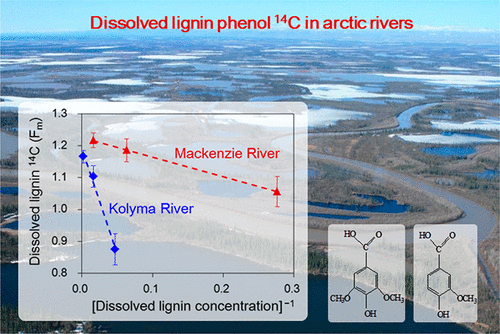当前位置:
X-MOL 学术
›
ACS Earth Space Chem.
›
论文详情
Our official English website, www.x-mol.net, welcomes your
feedback! (Note: you will need to create a separate account there.)
14C Variation of Dissolved Lignin in Arctic River Systems
ACS Earth and Space Chemistry ( IF 2.9 ) Pub Date : 2017-07-11 00:00:00 , DOI: 10.1021/acsearthspacechem.7b00055 Xiaojuan Feng 1, 2, 3 , Jorien E. Vonk 4 , Claire Griffin 5, 6 , Nikita Zimov 7 , Daniel B. Montluçon 3 , Lukas Wacker 8 , Timothy I. Eglinton 3
ACS Earth and Space Chemistry ( IF 2.9 ) Pub Date : 2017-07-11 00:00:00 , DOI: 10.1021/acsearthspacechem.7b00055 Xiaojuan Feng 1, 2, 3 , Jorien E. Vonk 4 , Claire Griffin 5, 6 , Nikita Zimov 7 , Daniel B. Montluçon 3 , Lukas Wacker 8 , Timothy I. Eglinton 3
Affiliation

|
Assessing permafrost-release signals in arctic rivers is challenging due to mixing of complex carbon components of contrasting ages. Compound-specific 14C analysis of terrestrially derived molecules may reduce the influence of mixed carbon sources and potentially provide a closer examination on the dynamics of permafrost-derived carbon in arctic rivers. Here we employed a recently modified method to determine radiocarbon contents of lignin phenols, as a classic tracer for terrestrial carbon, isolated from the dissolved organic matter (DOM) of two arctic river systems that showed contrasting seasonal dynamics and age components in DOM. While dissolved lignin had relatively invariant 14C contents in the Mackenzie, it was more concentrated and 14C-enriched during spring thaw but relatively diluted and 14C-depleted in the summer flow or permafrost thaw waters in the Kolyma. Remarkably, the covariance between dissolved lignin concentrations and its 14C contents nicely followed the Keeling plot, indicating mixing of a young pool of dissolved lignin with an aged pool of a constant concentration within the river. Using model parameters, we showed that although the young pool had similarly modern ages in both rivers, Kolyma had a much higher concentration of aged dissolved lignin and/or with older ages. With this approach, our study not only provided the first set of 14C data on dissolved lignin phenols in rivers but also demonstrated that the age and abundance of the old DOM pool can be assessed by radiocarbon dating of dissolved lignin in arctic rivers related to permafrost release.
中文翻译:

北极河流系统中溶解的木质素的14 C变化
由于年龄不同的复杂碳组分的混合,评估北极河流中的多年冻土释放信号具有挑战性。陆生分子的化合物特定的14 C分析可以减少混合碳源的影响,并有可能对北极河中多年冻土来源的碳的动力学进行更深入的研究。在这里,我们采用了一种最新改进的方法来确定木质素酚的放射性碳含量,这是陆地碳的经典示踪剂,它与两条北极河流系统的溶解有机物(DOM)分离,这些溶解有机物显示出相对的季节性变化和DOM中的年龄成分。尽管麦肯齐中溶解的木质素具有相对不变的14 C含量,但其浓度却更高,为14弹簧解冻期间C-富集但相对稀释和14在夏季流或永久冻土在科雷马解冻水域C-耗尽。值得注意的是,溶解的木质素浓度与其14 C含量之间的协方差很好地遵循了Keeling图,这表明河中有少量的溶解的木质素池与一定浓度的陈年池混合。使用模型参数,我们显示,尽管两条河流的幼池都具有相似的现代年龄,但Kolyma的老龄溶解木质素和/或年龄较大,浓度要高得多。通过这种方法,我们的研究不仅提供了第一组14关于河流中溶解的木质素酚的碳数据,但也表明,可以通过与永久冻土释放有关的北极河流中溶解的木质素的放射性碳测年来评估旧DOM库的年龄和丰度。
更新日期:2017-07-11
中文翻译:

北极河流系统中溶解的木质素的14 C变化
由于年龄不同的复杂碳组分的混合,评估北极河流中的多年冻土释放信号具有挑战性。陆生分子的化合物特定的14 C分析可以减少混合碳源的影响,并有可能对北极河中多年冻土来源的碳的动力学进行更深入的研究。在这里,我们采用了一种最新改进的方法来确定木质素酚的放射性碳含量,这是陆地碳的经典示踪剂,它与两条北极河流系统的溶解有机物(DOM)分离,这些溶解有机物显示出相对的季节性变化和DOM中的年龄成分。尽管麦肯齐中溶解的木质素具有相对不变的14 C含量,但其浓度却更高,为14弹簧解冻期间C-富集但相对稀释和14在夏季流或永久冻土在科雷马解冻水域C-耗尽。值得注意的是,溶解的木质素浓度与其14 C含量之间的协方差很好地遵循了Keeling图,这表明河中有少量的溶解的木质素池与一定浓度的陈年池混合。使用模型参数,我们显示,尽管两条河流的幼池都具有相似的现代年龄,但Kolyma的老龄溶解木质素和/或年龄较大,浓度要高得多。通过这种方法,我们的研究不仅提供了第一组14关于河流中溶解的木质素酚的碳数据,但也表明,可以通过与永久冻土释放有关的北极河流中溶解的木质素的放射性碳测年来评估旧DOM库的年龄和丰度。











































 京公网安备 11010802027423号
京公网安备 11010802027423号